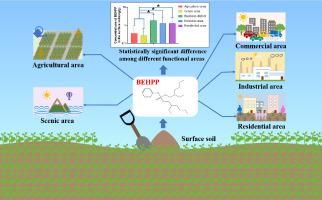Science of the Total Environment ( IF 8.2 ) Pub Date : 2021-01-22 , DOI: 10.1016/j.scitotenv.2021.145350 Shuai Gong , Yirong Deng , Kefan Ren , Weikun Meng , Langjie Ye , Cunliang Han , Guanyong Su

|
The organophosphate ester (OPE), bis-(2-ethylhexyl)-phenyl phosphate (BEHPP), was recently identified as an abundant contaminant in indoor dust samples; however, its pollution status in other matrices remains unknown. Here, n = 95 surface soil samples were collected from a prefecture-level city (hereafter referred to as D city) in South China during 2019, and further analyzed to accurately determine the concentrations of BEHPP and eight other OPEs, including tris(2-chloroethyl) phosphate (TCEP), tris(1,3-dichloro-isopropyl) phosphate (TDCIPP), triphenyl phosphate (TPHP), tris(2-butoxyethyl) phosphatetris (TBOEP), 2-ethylhexyl diphenyl phosphate (EHDPP), tris(2-ethylhexyl) phosphate (TEHP), 4-biphenylol diphenyl phosphate (BPDPP), and tris(2-biphenyl) phosphate (TBPHP). BEHPP was detected in all six functional areas (agricultural, scenic, commercial, industrial, and residential areas) of this region, and exhibited a high detection frequency of 67.4%, with a median concentration of 0.455 ng/g dry weight (DW range: nd-7.05 ng/g dw), regardless of the functional area. Samples from commercial, industrial, and residential areas contained significantly greater BEHPP concentrations than those from agricultural and scenic areas. Furthermore, strong and statistically significant correlations were observed between BEHPP and other OPE congeners, particularly for TEHP (r = 0.764, p < 0.001), TBOEP (r = 0.687, p < 0.001), and TPHP (r = 0.709, p < 0.001), indicating that BEHPP may have similar commercial applications and sources to these compounds in surface soil. Collectively, this study provides the first evidence of the presence of BEHPP in soil samples, and indicates that this emerging contaminant is widely distributed across all five functional areas of a typical region (South China).































 京公网安备 11010802027423号
京公网安备 11010802027423号